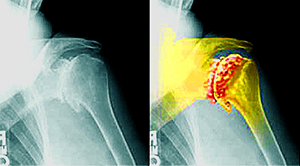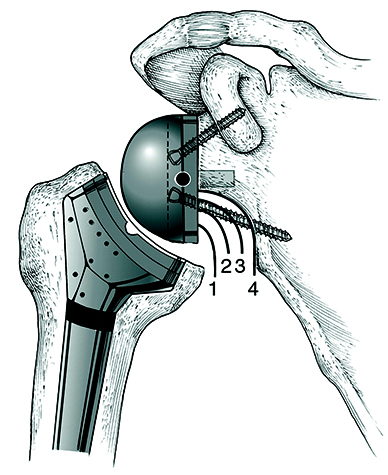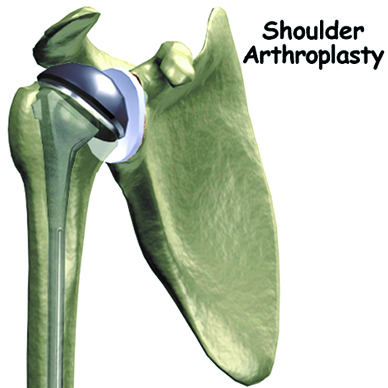Dr. Richard Harrison: Shoulder Arthritis Can Be Debilitating With Severe Pain, Loss of Motion
By Dr. Richard Harrison // May 30, 2016
CALL 321-802-5820 FOR AN APPOINTMENT

BREVARD COUNTY, FLORIDA – Shoulder arthritis can be a debilitating illness. It often presents with pain and loss of motion, usually involving a loss of ability to internally rotate the shoulder.

This would be similar to reaching into a back pocket or clasping a bra behind the back. Patients also notice an aching pain deep in the shoulder.
Arthritis is simply a medical description for pain and inflammation in a joint, which most commonly results from loss of cartilage. When bones glide against each other, healthy joint cartilage allows less friction, easier gliding, and minimal pain.
As the cartilage wears away over time, the bone surfaces become more sensitive and inflamed. As the condition progresses, the body can produce extra bone at the edges of the cartilage surface, called osteophytes.
To increase stability and control of the shoulder, the body has muscles and tendons surrounding the shoulder called the rotator cuff. The presence of an intact and functioning rotator cuff is very important to a smoothly functioning shoulder.
Shoulder arthritis may result from a traumatic event such as a fracture or dislocation.
Unstable shoulders are also at risk of developing shoulder arthritis. The shoulder is a ball and socket joint, with the humeral head of the arm acting as the ball and the shallow socket is called the glenoid, which allows the wide range of motion most people enjoy with the shoulder.
To increase stability and control of the shoulder, the body has muscles and tendons surrounding the shoulder called the rotator cuff. The presence of an intact and functioning rotator cuff is very important to a smoothly functioning shoulder.
SHOULDER ARTHRITIS INITIALLY MANAGED NONOPERATIVELY
Initially, arthritis pain can be addressed nonoperatively. There are multiple options to improving function without surgery. Many patients initially turn to over-the-counter medications such as Tylenol (acetaminophen) or nonsteroidal anti-inflammatories such as Aleve, Advil, Motrin.

Some patients improve with the application of heat, while others use ice at the end of the day. There have been patients who have had some improvement with nontraditional medical therapies such as acupuncture, yoga or massage.
Avoidance of heavy lifting and aggravating activities has been used by some patients to improve symptoms.
Additional modalities include topical pain creams or arthritis creams and TENS units, which supplies external low voltage electrical stimuli to desensitize the nerves in the area where the patient is feeling pain. The injection of corticosteroids into the joint can decrease inflammation and some of the arthritis pain temporarily.
Unfortunately, we do not yet have a method to reliably restore degenerated cartilage, and there is a theoretical risk of thinning the rotator cuff tendons with multiple steroid injections into the shoulder.
SURGICAL OPTIONS DECREASE PAIN AND RESTORE EVERYDAY FUNCTION
Ultimately, patients with shoulder arthritis reach a point where their pain cannot be controlled with a conservative nonoperative approach adequately, and they prefer to move forward with surgery to enjoy regular activities of life without pain. Some patients just want to be able to maintain independence with grooming and dressing.
After recovery many patients are able to return to golf, tennis or holding a grandchild. Even simple chores around the house such as laundry, putting away dishes and living independently can be restored in patients with significant arthritis.
There are multiple options for performing surgical intervention for arthritis. A total shoulder arthroplasty or “shoulder replacement” has become the standard of care for treating this condition. This procedure involves removing some bone from the head or ball of the humerus and replacing that with a stem and ball constructed of metal.
The socket portion of the joint is resurfaced with a specially developed plastic to allow improved gliding and decreased pain. This plastic is often cemented into place with a specialized adhesive made of polymethylmethacrylate.
Shoulder arthritis may result from a traumatic event such as a fracture or dislocation. Unstable shoulders are also at risk of developing shoulder arthritis. The shoulder is a ball and socket joint, with the humeral head of the arm acting as the ball and the shallow socket is called the glenoid, which allows the wide range of motion most people enjoy with the shoulder.
Initially, surgeons proceeded with a procedure called hemiarthroplasty, which just replaces the ball of the shoulder joint. While this procedure is technically easier to perform, most scientific studies have shown that the results are not long lasting and many patients proceed to revisions for a total shoulder arthroplasty.
The vast majority of these operations depend on the presence of an intact and functioning rotator cuff to be successful. If these tendons are not intact and functioning, the regular native shoulder will not be functioning well, and a standard shoulder replacement will not function. In this instance, we perform a reverse shoulder arthroplasty.
This is a reconstructive surgery that has had significant technological improvement over the past two decades. With this procedure the ball portion of the joint is screwed into the glenoid or socket, and the cup portion is placed on the arm or humeral shaft. This prosthesis does not require an intact rotator cuff to function, but uses leverage on the shoulder and a functioning deltoid.
Regardless of what procedure is performed, there are some limitations to the amount of weight patients can lift after surgery.
BONE-SPARING TOTAL SHOULDER REPLACEMENT EFFECTIVE IN YOUNG PATIENTS
What do we do when a young person has severe, painful, activity-limiting arthritis of the shoulder? We previously have not had many good options. One option currently available is a bone-sparing total shoulder replacement.

This surgery utilizes special instrumentation to resurface the ball of the humeral head with a metal cup and inlay a piece of plastic inside the surrounding glenoid bone stock.
While this operation will not likely last the entire patient’s lifetime, it will allow them to perform more functional activities without weight bearing restrictions during the early, active portion of his or her life.
Why not put this bone-sparing prosthesis in every patient? This prosthesis requires the presence of adequate strong bone to function without loosening. Unfortunately, as patients collect birthdays and age, bone becomes thinner, less dense, and weaker as a natural fact of life.
The majority of patients who would be the candidates for a shoulder replacement often do not have enough dense bone stock to adequately accept the bone sparing prosthesis.
REHAB STARTS WITHIN DAYS OF SURGERY
After surgery most patients stay overnight in the hospital, but some may undergo these types of surgeries on an outpatient basis. Patients usually leave the hospital in a sling and expect to begin therapy in the first few days.

A total shoulder arthroplasty requires cutting one of the rotator cuff tendons on the front of the shoulder to allow access to perform the procedure.
At the conclusion of the procedure, this tendon is repaired back to its original starting point. The therapy program for the first 6 weeks after the procedure focuses on regaining and maintaining motion while protecting this vital tendon repair.
Not all shoulder pain is arthritis, and not all shoulder pain or arthritis requires surgery. If you are experiencing pain, be sure to have a discussion with your doctor about your diagnosis and the treatment options available for you.
For more information and to make an appointment with Dr. Richard Harrison, call 321-802-5820 or visit www.MyDoctor321.com/SCD
ABOUT THE AUTHOR
Dr. Richard Harrison is Board Certified in Orthopedic Surgery with additional sub-specialty board certifications in Hand Surgery and Sports Medicine, Dr. Harrison joined the staff of First Choice Medical Group in 2013 following a four month deployment to Kaiserslautern, Germany as Lieutenant Colonel in the U.S. Army Reserves Medical Corp.

He is a graduate of the Baylor College of Medicine where he earned his Medical Degree.
He completed his internship and residency in Orthopedic Surgery at Jackson Memorial Hospital in Miami, Florida, followed by a Hand and Limb Fellowship at St. Luke’s/Roosevelt Medical Center in New York City, which also included training in Melbourne, Australia and congenital hand surgery training at Texas Scottish Rite Hospital in Dallas, Texas.
At First Choice Medical Group, Dr. Harrison’s practice focuses on total shoulder replacements and replacement revisions, rotator cuff repair, fracture treatment, sports injuries and hand surgery.
For more information and to make an appointment with Dr. Richard Harrison, call 321-802-5820 or visit www.MyDoctor321.com/SCD
CLICK HERE FOR MORE BREVARD COUNTY HEALTH NEWS













